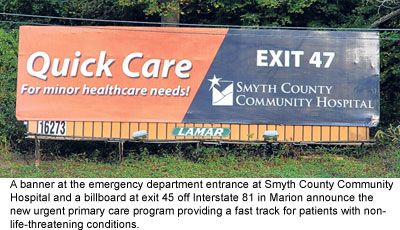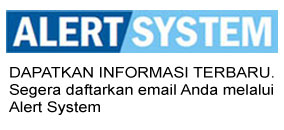 Linda Burchette
Linda Burchette
You sprain your wrist, develop a severe cough or suffer a cut that needs stitches but is not life-threatening.
This happens in the evening or on the weekend when your doctor’s office is closed.
What do you do?
Until last month, the only choice in Smyth County was to go to the emergency department at Smyth County Community Hospital in Marion and perhaps endure a long wait. If the staff was dealing with life-threatening emergencies such as gunshot or knife wounds, auto accident victims or patients with chest pains or breathing problems, the wait could be even longer.
Now there is an alternative for those patients needing urgent but not emergency care. It is the new fast track urgent primary care program at SCCH.
“We like to refer to it as fast track. The official name is Quick Care for minor healthcare needs,” said Lindy White, chief operating officer at SCCH.
“We have created a faster process for care for minor clinical care, such as injury from a fall, severe sore throat, anything other than a truly life-threatening condition,” White explained. “A shorter wait time is our goal for patients seeking primary care.”
White said the goal is for a patient to be seen in Quick Care within 15 minutes, to have the patient spend no more than 54 minutes from the time they arrive to the time they are able to leave.
The model for Quick Care was implemented in August with marketing beginning in September. The model was created, White said, from patient feedback and with the help of a team mapping out the process.
The problem of long wait times in the emergency department was causing some patients to seek urgent care outside the county, White said. She said she didn’t know if they were getting faster care elsewhere but she did know that SCCH was losing potential patients because of a long wait in the emergency department for after-hours non-emergency care.
“We are not competing with private physicians,” White said. “We encourage patients to go to their regular physicians whenever possible. This service is for non-emergency care after hours and on weekends when physicians’ offices are closed.”
White said she met with local physicians to explain what the hospital is doing and received mostly positive response, and the hospital board is also supportive.
“We do not need people going outside the community for primary care,” White said she told the physicians. That could lead to a loss of patients for both the hospital and local physicians. Both need the support of local residents to continue providing health care.
One local doctor has offered to provide care at the hospital’s urgent care facility. White hopes other physicians will participate as well.
The clinical model set up for SCCH Quick Care has a dedicated nurse practitioner or physician’s assistant and a nurse seven days a week. A triage nurse first sees the patient to determine symptoms for either emergency or urgent care. Currently, Quick Care is offered in the hospital’s emergency department but will soon be moved to a separate location. The goal, said White, is to establish an urgent care clinic off the hospital campus in a more centralized area with evening hours Monday through Friday and extended hours on Saturday and Sunday.
“Right now what we’ve done is improve clinical care and wait time,” said White. “This is just the first phase. To meet the model we need to move urgent care to the medical building and ultimately (within 12-14 months) move off-site to a more convenient location.”
There is always one doctor in the emergency department and the medical director is on call plus there is the hospitalist team at the hospital for additional help in the event of multiple emergencies.
“We are lucky to have these resources available at a small hospital in a small town,” White said.
The urgent care clinic is also not competing with the county’s free clinic as fees will be charged at the urgent care clinic based on the level of acuity, said White. Some insurance companies require a higher co-pay for urgent care than for regular physician office visits but an even higher co-pay for visits to an emergency department. Having urgent care available in a separate location than the emergency department will save patients money as well as time.
Having urgent care separate from the emergency department is also a requirement in some provisions of Medicare and Medicaid, White said.
Patient feedback is indicating satisfaction in early results of urgent care, White said.
“We’ve seen scores go up tremendously, from 86.5 to 91 in the first month of data.”
The urgent primary care model was designed as part of the hospital’s lean management program to serve the needs of the community and developed with the help of front line staff team members.
“They know what the patients need and the priorities,” said White. “Who better to develop that than the team working back there? We feel that’s why it’s been successful, because we got the team engaged. There has been a lot of excitement with the team. It just came together.”
Source: tricities.com








